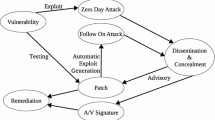Abstract
To measure the trustworthiness of Internetware, we need to understand the existing problems and design appropriate trustworthy metrics. The developing and running system of Internetware is analyzed in terms of process, keystone, methods and techniques. According to the main related factors of Internetware trustworthiness, two important models, namely trustworthy metrics hierarchy model of components (TMHMC) with computing steps and local-global trustworthy metrics model of platform (LGTMMP) with algorithm respectively, are employed to evaluate the internal and external trustworthiness of Internetware benefiting for the development of Internetware.
Similar content being viewed by others
References
Yang Fuqing. Thinking on the Development of Software Engineering Technology[J]. Journal of Software, 2005, 16(1): 1–7(Ch).
Ye Zhaohua, Tang Mingduan. Improved Framework for Software Project Metrics[J].Systems Engineering and Electronics, 2004, 26(11): 1694–1697(Ch).
Hamlet D, Mason D, Woit D. Theory of Software Reliability Based on Components[C]//Proc of the 3rd Int Workshop on Component-Based Software Engineering. Toronto: IEEE Computer Society Press, 2001: 361–370.
Yang Fuqing, Mei Hong, Lu Jian, et al. Some Discussion on the Development of Software Technology[J]. Acta Electronica Sinica, 2002, 30(12): 1901–1906(Ch).
Hasselbring W, Reussner R. Toward Trustworthy Software Systems[J]. Computer, 2006, 39(4): 91–92.
Zhou Y, Leung H. Predicting Object-Oriented Software Maintainability Using Multivariate Adaptive Regression Splines[J]. Journal of Systems and Software 2007, 80(8): 1349–1361.
Shi E, Perrig A, van Doorn L. A Fine-Grained Attestation Service for Secure Distributed Systems [C]//Proc of the IEEE Symposium on Security and Privacy. Oakland: IEEE Press, 2005: 154–168.
Kokol P, Brest J, Zorman M, Podgorelec V. Integration of Complexity Metrics with the Use of Decision Trees[J]. Software Engineering Notes, 1998, 23(1): 56–58.
Neil M, Tailor M, Marquez D, et al. Modelling Dependable Systems Using Hybrid Bayesian Networks[J]. Reliability Engineering & System Safety, 2008, 93(7): 933–939.
Chang C, Wu C R, Lin H L. Integrating Fuzzy Theory and Hierarchy Concepts to Evaluate Software Quality[J]. Software Quality Journal, 2008, 16(2): 263–276.
Grosser D, Sahraoui H A, Valtchev P. Predicting Software Stability Using Case-Based Reasoning[C]//Proceedings of ASE 2002: 17th IEEE International Conference on Automated Software Engineering. Edinburg: IEEE Press, 2002: 295–298.
Kanmani S, Uthariaraj V R, Sankaranarayanan V, et al. Object-Oriented Software Fault Prediction Using Neural Networks[J]. Information and Software Technology, 2007, 49(5): 483–492.
Patel J, Teacy W T L, Jennings N R, et al. A Probabilistic Trust Model for Handling Inaccurate Reputation Sources [C]//Proceedings of Third International Conference Trust Managemen (iTrust’2005), Berlin: Springer-Verlag, 2005: 193–209.
Author information
Authors and Affiliations
Corresponding author
Additional information
Foundation item: Supported by the Program for New Century Excellent Talents in University (NCET-06-0762), the Specialized Research Fund for the Doctoral Program of Higher Education (20060611009) and the Natural Science Foundations of Chongqing (CSTC2007BA2003, CSTC2006BB2003)
Rights and permissions
About this article
Cite this article
Zhang, Y., Fang, B. & Xu, C. Trustworthy metrics models for internetware. Wuhan Univ. J. Nat. Sci. 13, 547–552 (2008). https://doi.org/10.1007/s11859-008-0507-4
Received:
Published:
Issue Date:
DOI: https://doi.org/10.1007/s11859-008-0507-4




